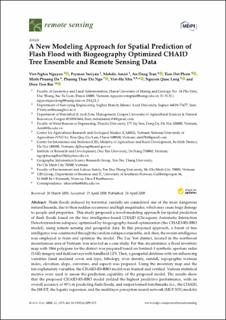| dc.identifier.citation | Nguyen, V. N., Yariyan, P., Amiri, M., Dang Tran, A., Pham, T. D., Do, M. P., ... & Tien Bui, D. (2020). A new modeling approach for spatial prediction of flash flood with biogeography optimized chaid tree ensemble and remote sensing data. Remote Sensing, 12(9). | en_US |
| dc.description.abstract | Flash floods induced by torrential rainfalls are considered one of the most dangerous natural hazards, due to their sudden occurrence and high magnitudes, which may cause huge damage to people and properties. This study proposed a novel modeling approach for spatial prediction of flash floods based on the tree intelligence-based CHAID (Chi-square Automatic Interaction Detector)random subspace, optimized by biogeography-based optimization (the CHAID-RS-BBO model), using remote sensing and geospatial data. In this proposed approach, a forest of tree intelligence was constructed through the random subspace ensemble, and, then, the swarm intelligence was employed to train and optimize the model. The Luc Yen district, located in the northwest mountainous area of Vietnam, was selected as a case study. For this circumstance, a flood inventory map with 1866 polygons for the district was prepared based on Sentinel-1 synthetic aperture radar (SAR) imagery and field surveys with handheld GPS. Then, a geospatial database with ten influencing variables (land use/land cover, soil type, lithology, river density, rainfall, topographic wetness index, elevation, slope, curvature, and aspect) was prepared. Using the inventory map and the ten explanatory variables, the CHAID-RS-BBO model was trained and verified. Various statistical metrics were used to assess the prediction capability of the proposed model. The results show that the proposed CHAID-RS-BBO model yielded the highest predictive performance, with an overall accuracy of 90% in predicting flash floods, and outperformed benchmarks (i.e., the CHAID, the J48-DT, the logistic regression, and the multilayer perception neural network (MLP-NN) models). We conclude that the proposed method can accurately estimate the spatial prediction of flash floods in tropical storm areas. | en_US |

